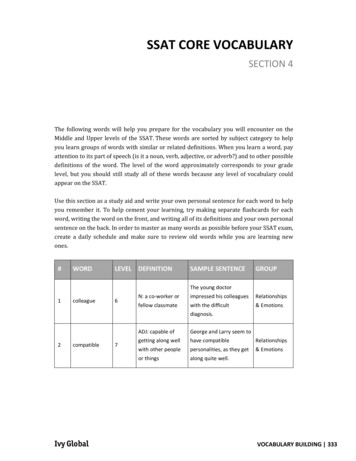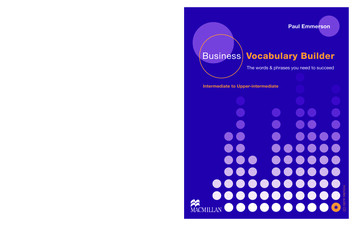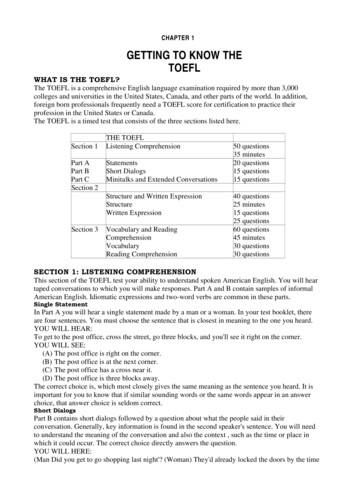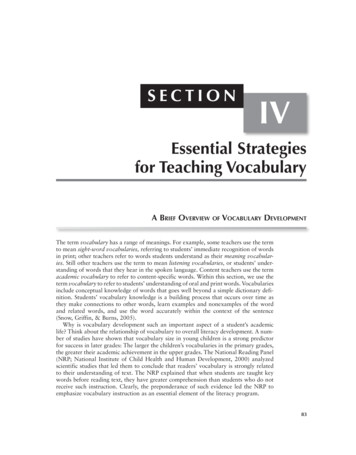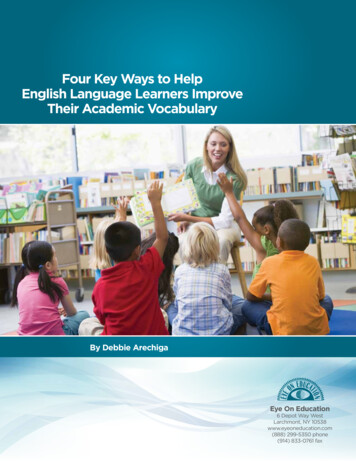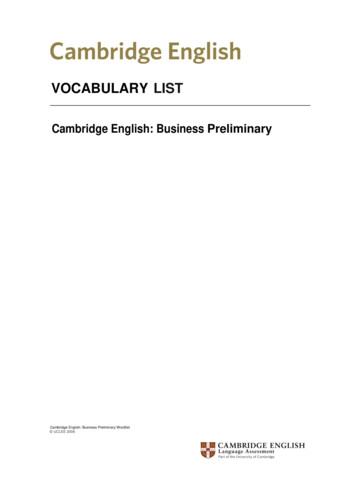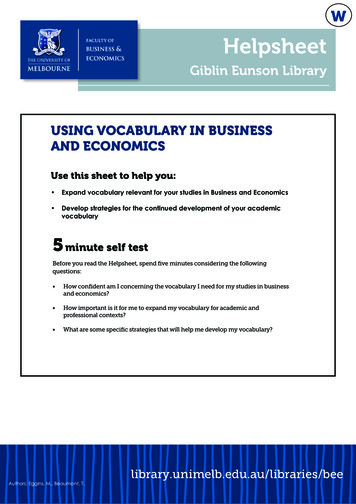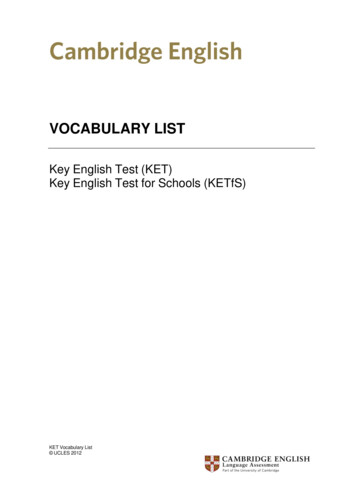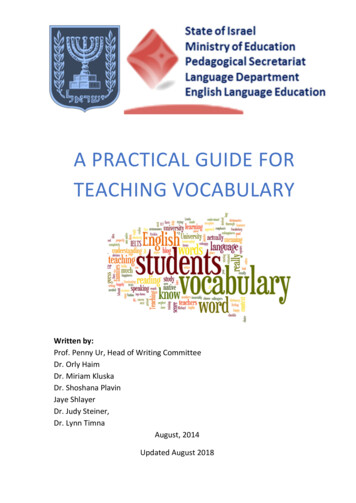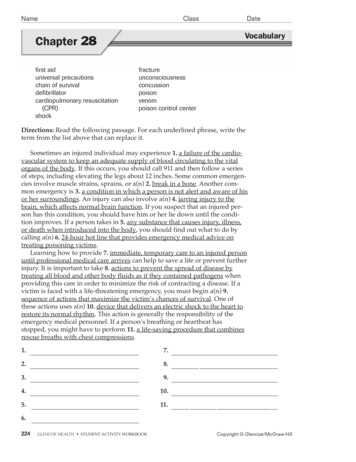
Transcription
NameClassDateVocabularyChapter 28first aiduniversal precautionschain of survivaldefibrillatorcardiopulmonary ussionpoisonvenompoison control centerDirections: Read the following passage. For each underlined phrase, write theterm from the list above that can replace it.Sometimes an injured individual may experience 1. a failure of the cardiovascular system to keep an adequate supply of blood circulating to the vitalorgans of the body. If this occurs, you should call 911 and then follow a seriesof steps, including elevating the legs about 12 inches. Some common emergencies involve muscle strains, sprains, or a(n) 2. break in a bone. Another common emergency is 3. a condition in which a person is not alert and aware of hisor her surroundings. An injury can also involve a(n) 4. jarring injury to thebrain, which affects normal brain function. If you suspect that an injured person has this condition, you should have him or her lie down until the condition improves. If a person takes in 5. any substance that causes injury, illness,or death when introduced into the body, you should find out what to do bycalling a(n) 6. 24-hour hot line that provides emergency medical advice ontreating poisoning victims.Learning how to provide 7. immediate, temporary care to an injured personuntil professional medical care arrives can help to save a life or prevent furtherinjury. It is important to take 8. actions to prevent the spread of disease bytreating all blood and other body fluids as if they contained pathogens whenproviding this care in order to minimize the risk of contracting a disease. If avictim is faced with a life-threatening emergency, you must begin a(n) 9.sequence of actions that maximize the victim’s chances of survival. One ofthese actions uses a(n) 10. device that delivers an electric shock to the heart torestore its normal rhythm. This action is generally the responsibility of theemergency medical personnel. If a person’s breathing or heartbeat hasstopped, you might have to perform 11. a life-saving procedure that combinesrescue breaths with chest compressions.1. shock7. first aid2. fracture8. universal precautions3. unconsciousness9. chain of survival4. concussion10. defibrillator5. poison11. cardiopulmonary resuscitation (CPR)6. poison control center224GLENCOE HEALTH STUDENT ACTIVITY WORKBOOKCopyright Glencoe/McGraw-Hill
NameActivity 103ClassDateApplying Health SkillsFOR USE WITH CHAPTER 28, LESSON 1When You’re the Only One Who Can HelpDirections: Provide step-by-step first-aid instruction for each case below.1. You walk downstairs and find your younger brother holding his hand. It isbleeding heavily. The laceration is deep and runs across the palm of hishand. Through his tears, he tells you that he cut his hand on a piece ofglass. No one else is home.Recommended first-aid procedures:2. The eight-year-old boy you are babysitting comes in sobbing and holdinghis knee. He tells you he fell while skateboarding. After pulling his handsaway from his knee, you discern that the wound is bleeding; fortunately, itappears only to be a mild abrasion.Recommended first-aid procedures:3. Walking home from a friend’s house, you hear an odd “whooshing” noise,then cries of pain coming from beside your neighbor’s house. When youinvestigate, you find your neighbor on the ground near his grill. He isclearly in pain and his hands are red and partially covered with blisters.Flames are coming from his grill, reaching over a foot in height. No oneis home at your house and you know your neighbor lives alone.Recommended first-aid procedures:Copyright Glencoe/McGraw-HillGLENCOE HEALTH STUDENT ACTIVITY WORKBOOK225
NameActivity 104ClassDateApplying Health SkillsFOR USE WITH CHAPTER 28, LESSON 2Handling Major EmergenciesDirections: Read each situation below. Provide step-by-step instructions forfirst-aid care for each situation.1. A four-year-old boy was playing near a pool when his mother went intothe house to take a phone call. When the mother went back out, the boywas lying face down in the water. The boy is not moving, coughing, orbreathing.First-aid care:2. A man was involved in a car accident. He does not appear to be bleeding.He is very restless, nauseous, pale, and has a rapid pulse. He is in shock.First-aid care:3. A woman at a food court in a shopping mall appears to be choking on ahamburger. She is turning blue in the face.First-aid care:226GLENCOE HEALTH STUDENT ACTIVITY WORKBOOKCopyright Glencoe/McGraw-Hill
NameClassDateApplying Health SkillsActivity 105FOR USE WITH CHAPTER 28, LESSON 3Handling Common EmergenciesDirections: You may be faced with situations in which a friend or relativeexperiences some minor injury. Knowing how to handle these situationscan help to ease the victim’s pain and prevent further complications. Readeach situation below. Then describe what action you would take in handlingthe situation.1. You and a friend are hiking in the woods. Your friend steps on a branch andtwists his ankle. The ankle is painful and swollen. What kind of injury isyour friend experiencing? What action should you take?2. You are standing in a long line with your sister. It is hot and she faints. Howwill you help her?3. You are babysitting the little girl next door. She is teasing your dog, and thedog bites her. There is a little bleeding, and the wound appears to beswollen. How should you handle this?Copyright Glencoe/McGraw-HillGLENCOE HEALTH STUDENT ACTIVITY WORKBOOK227
NameActivity 106ClassDateApplying Health SkillsFOR USE WITH CHAPTER 28, LESSON 4Poisonings: When Time Is CriticalDirections: Describe proper first-aid treatment for each poisoning example below.1. Swallowed poisonFirst-aid treatment:2. Poison in the eyeFirst-aid treatment:3. Insect stingFirst-aid treatment:4. Poison ivy, oak, or sumacFirst-aid treatment:5. Poisonous snakebiteFirst-aid treatment:228GLENCOE HEALTH STUDENT ACTIVITY WORKBOOKCopyright Glencoe/McGraw-Hill
NameClassStudy GuideChapter 28STUDY TIPS:Date Read You’ll Learn To for each lesson. Look up the meaning of any unfamiliar vocabulary terms. Read the questions below before you read the chapter.Directions: As you read the chapter, answer the following questions. Later,you can use this guide to review the information in the chapter.Lesson 11. What is first aid?First aid is the immediate, temporary care given to an ill or injured person until professionalmedical care can be provided.2. Why is it important to use universal precautions when administering first aid?It is important to use universal precautions to minimize the risk of transmitting diseasethrough contact with blood and other body fluids.3. What is the difference between an abrasion and a laceration?An abrasion occurs when the skin is scraped against a hard surface, causing tiny bloodvessels in the outer layers of the skin to be broken; a laceration occurs when a sharp objectslices through the layers of skin, causing bleeding.4. What are the steps in controlling bleeding in an open wound?Cover the wound with a sterile gauze and press firmly; elevate the wound above the level ofthe heart; cover the gauze with a sterile bandage; if necessary, cover the dressing with apressure bandage and/or use pressure point bleeding control; call for help.5. Describe the three types of burns.First-degree burns involve only the outer layer of skin; second-degree burns involve the topseveral layers of skin, causing blisters and a blotchy appearance; third-degree burns destroydeeper layers of skin and possibly nerves, muscles, and bones.Lesson 26. Describe the four links in the chain of survival.Phone 911, begin CPR, defibrillation, and transfer to advanced care.7. What is CPR and when should it be used?Cardiopulmonary resuscitation (CPR) is a life-saving first-aid procedure that combinesrescue breaths with chest compressions, supplying oxygen to the body until normal bodyCopyright Glencoe/McGraw-HillGLENCOE HEALTH STUDENT ACTIVITY WORKBOOK229
NameStudy Guide, Chapter 28ClassDate(Continued)functions can resume. CPR should be used when a person’s breathing and heartbeat havestopped.8. What are the symptoms of shock?restlessness; altered consciousness; nausea; pale or ashen appearance; cool, moist skin; andrapid breathing and pulseLesson 39. What is the difference between a strain and a sprain?A strain is an injury to a muscle, whereas a sprain is an injury to a ligament.10. What is a fracture?a break in the bone11. What are the steps for treating an animal bite?Wash the bite area with mild soap and warm water; if the wound is bleeding, use directpressure or pressure point bleeding control to stop the bleeding; apply ice to reduceswelling; cover bite area with a clean dressing.12. How should a nosebleed be treated?The person should keep quiet, sit down, and lean forward; apply direct pressure by pressingon the bleeding nostril; if bleeding continues after 15 minutes, repeat the procedure; seekmedical help if bleeding continues.Lesson 413. Define poison.Poison is any substance that causes injury, illness, or death when introduced into the body.14. How should poison on the skin be treated?It should be removed quickly to limit the exposure to the body; remove contaminatedclothing; continuously rinse the skin with water for 15 minutes; rinse the skin with mildsoap and water and rinse again with fresh water; call 911 while rinsing the skin.15. Who needs immediate medical attention if stung by a bee?people who are highly allergic to bee stings230GLENCOE HEALTH STUDENT ACTIVITY WORKBOOKCopyright Glencoe/McGraw-Hill
Provide step-by-step instructions for first-aid care for each situation. 1. A four-year-old boy was playing near a pool when his mother went into the house to take a phone call. When the mother went back out, the boy was lying face down in the water. The boy is not moving, coughing, or breathing. First-
